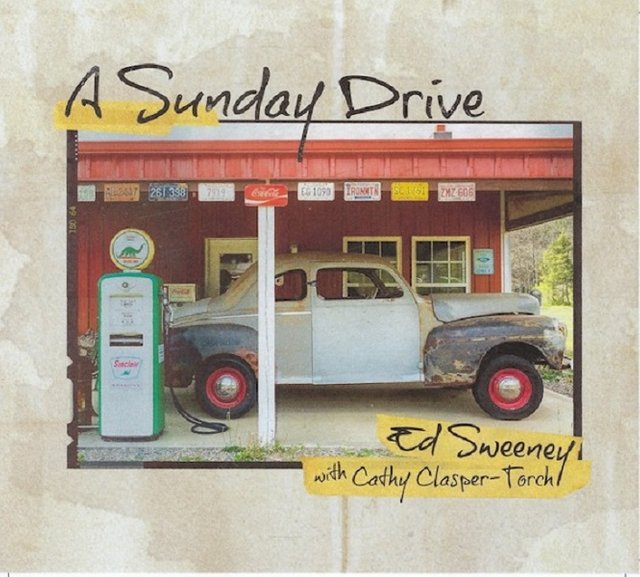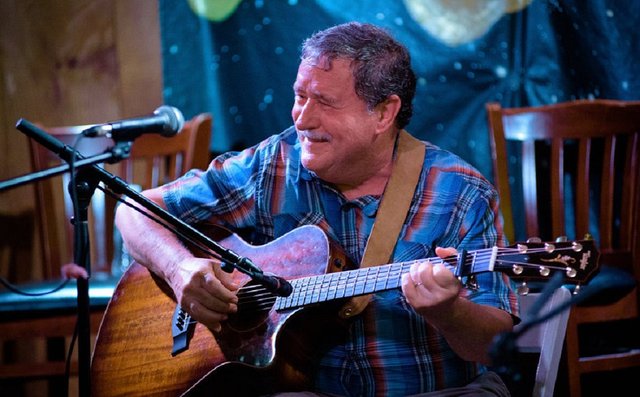
Ed Sweeney is readying for the release of a new album. It's titled A Sunday Drive, features Cathy Clasper-Torch and has a drop date of October 6. But first, for those of you not yet familiar with the act in question, a bit o’ background.
Ed Sweeney

According to his official website, folk artist Ed Sweeney is an experienced American singer-songwriter and musician. Sweeney’s purpose as a performer is to honor “people and their histories by presenting music that entertains and educates.” He writes songs he hopes will help audiences “understand the motivations, stories, and culture that have made us who and what we are today.”
Sweeney has “a wide-ranging repertoire on 6-and 12-string guitar, 5-string banjo, and fretless banjo” and has performed internationally “in almost any venue imaginable theatres, coffee houses, schools, clubs, festivals, [and] house concerts.” His music has been featured on NPR and “hundreds of radio stations and online networks around the world.” It has also been included in documentaries by Christian de Rezendes and Ken Burns, soundtracks, and is now “played in Disneyland,
Disneyland Paris & Disneyland Tokyo.”
Cathy Clasper-Torch
Cathy Clasper-Torch is a multi-instrumentalist, recording artist, performer, and teacher. Her instruments of choice are the violin, piano, erhu, and cello. She “plays and collaborates with numerous bands and musicians in Rhode Island and New England.” According to her official website, her solo disc is titled Here Between.
Signature Sound
Ed Sweeney’s signature sound is a fluid mix of multiple music genres including Americana, acoustic blues, folk, and traditional. He has “an eclectic taste in music” and on this album, anyway, one might even hear a bit of acoustic rock.
A Sunday Drive
A Sunday Drive is Sweeney's ninth recording. It is an 11-track album that features all cover cuts. It features Sweeney on vocals, guitar, and banjos; and Clasper-Torch on fiddle, cello, and erhu.
According to an email, the new release explores various themes but more importantly “takes inspiration from long leisurely car rides encountering a variety of music on the car radio and people met along the way.” Specifically, it “was inspired by an image photographer Cindy Wilson shared on social media. Cindy's photo of an old car sitting in front of a gas station now graces the cover of this album.
“Everything, including the station, had been abandoned for years, the car, tire rims, license plates, gas pumps - one of the pumps even had leaded gasoline at 32 cents a gallon in the photo.”
As noted in the email, the performing pair essentially “wanted to capture the variety of music heard over the car radio, at a farmer's market, or sung or played from a front porch as you drive around.” Combine that with Sweeney’s touring experience, driving “over 500,000 miles performing over the years” and you have A Sunday Drive.
Track by Track
He said: “I learned this song from the recordings of Frank Profitt of North Carolina. His playing was initially recorded in 1937 by Anne & Frank Warner. His songs and playing inspired many to learn roots music.”
Sweeney added some background: “Stephen wrote this song in 1986. He asked me to perform this song with him at his 70th birthday party this past June. When I received this song, I was recovering from major heart surgery I had in March. ‘Right Foot Out’ was a strong motivator for me to focus on my surgery and recovery. I believe a great song invites people to make the song personally relevant to them.”
The classic cowboy cut “Bury Me Not On The Lone Prairie” is the premiere single. While one can question its choice as a single, this recording unarguably includes a sense of sincerity and even genuineness. Perhaps that’s partly due to Sweeney’s choice of instruments.
Here on this 19th century song first recorded by Carl T. Sprague, he plays a “fretless banjo.” Clasper-Torch takes up a traditional Chinese instrument known as an erhu and Daryl Black Eagle Jamieson guests on drums and rattle.
Sweeney explains: “This is a song of loneliness felt as you are dying. We tried to capture what was the reality for many: your body and the memory of you is left behind at death. We played a traditional American instrument (Fretless Banjo), a traditional Chinese instrument (Erhu), and a Native American Drum & Rattle to try to honor the history and cultures of the unmarked graves of the prairie.”
Beatles fans will be happy to hear this instrumental cover of ex-Beatle George Harrison’s “While My Guitar Gently Weeps”. After all, some of us believe you can’t have a truly complete playlist without a Beatles song. Sweeney spoke of the choices they made adapting this classic cut.
He noted: “My friend Cathy Clasper-Torch and I reimagined ‘While My Guitar Gently Weeps’ as an instrumental. The Beatles were one of the most influential songwriters, and recording artists of my lifetime. George Harrison’s melody is so provocative. You don’t need to sing to feel its emotion.”
The performing pair presents their tuneful take on the traditional “Walking Boss” next. Sweeney explained what the song is about for those not in the know. “A walking boss was in charge of laborers as the railroad tracks were being built across the country. These laborers worked long hours, received little pay, ate poor food, and had little protection from the elements.”
He also discussed his history with the piece as well. “I learned ‘Walking Boss’ from the recordings of Clarence Ashley of Tennessee & North Carolina. Clarence Ashley was performing in medicine shows by 1911 and gained fame in the 1920s.”
To his credit, Sweeney certainly sounds like he himself has been performing this one for years. It’s certainly a great traveling troubadour everyman adaptation. It’s also quite reminiscent of something Woody Guthrie would have had in his knapsack of songs.
“Every car ride or road trip ‘needs’ music to play. I wrote an instrumental idea which I played for Cathy. She joined in and it turned into something a little more.”
Sweeney elaborates: “This hymn might have gone unnoticed except for Elizabeth Cotton. She remembered this hymn from her childhood in North Carolina and recorded it in 1958. I learned how to play and sing the first verse from her 1958 recording. The hymn was written in the 1880s – 1890s by Austin Miles. I found the 2nd verse in a 1900s hymnal.”
“A Childhood Medley” follows. It is a fun, unobtrusive, instrumental album entry included perhaps to balance out some of the more serious selections here. It includes a trio of childhood faves: “Frère Jacques”, “The Mickey Mouse Club March” and “Grandfather’s Clock”.
It’s a nice kiddie cut that Sweeney arranged unintentionally. He admits: “I created this medley by accident. I was working on one melody when I noticed that another melody seemed similar in an odd way. These melodies could be crafted to flow in and out of each other and still be fun.”
“My mother emigrated to this country from Ireland, alone, when she was a young woman in the late 1940s. My family moved around throughout my childhood. I lived in 7 states by the time I was 15.
“‘Distant Shore’ is a song where you know what is left behind, but you are both resigned and committed to go to a new destination.” Give it a close listen. In the end, it makes an effective album endnote.
Overall…
Overall, this is a refreshing, clever concept album at a time when other artists insist on serving up nothing but suit-approved singles. This unique tuneful trek through many miles of Americana is eclectic, exceptional, and a fine example of the pair’s personal performing tastes and Sweeney’s on-the-road experiences and assorted influences. So, pick up Ed Sweeney’s A Sunday Drive, featuring Cathy Clasper-Torch, and enjoy “A Little Traveling Music”.
(Images courtesy of Ed Sweeney)